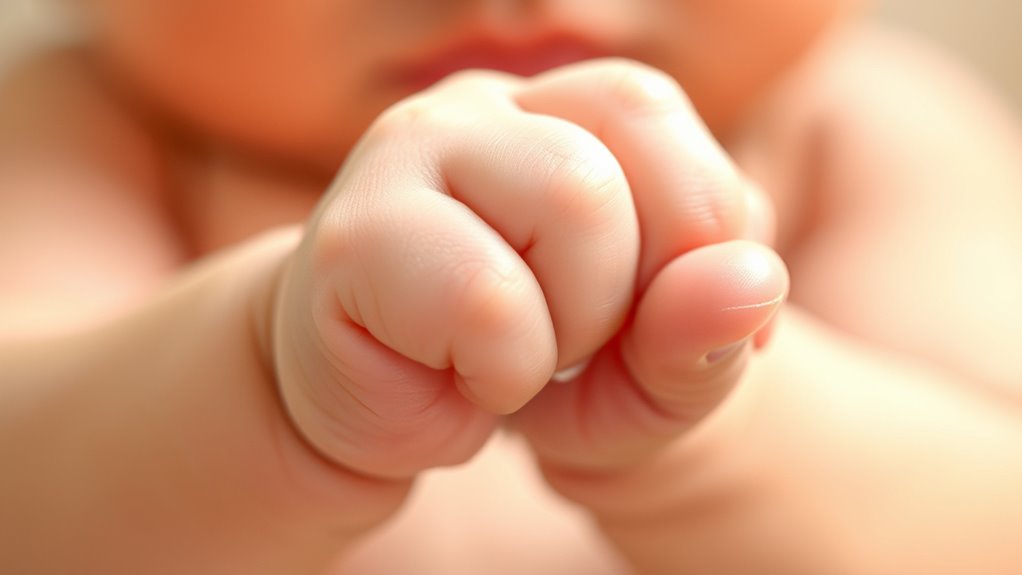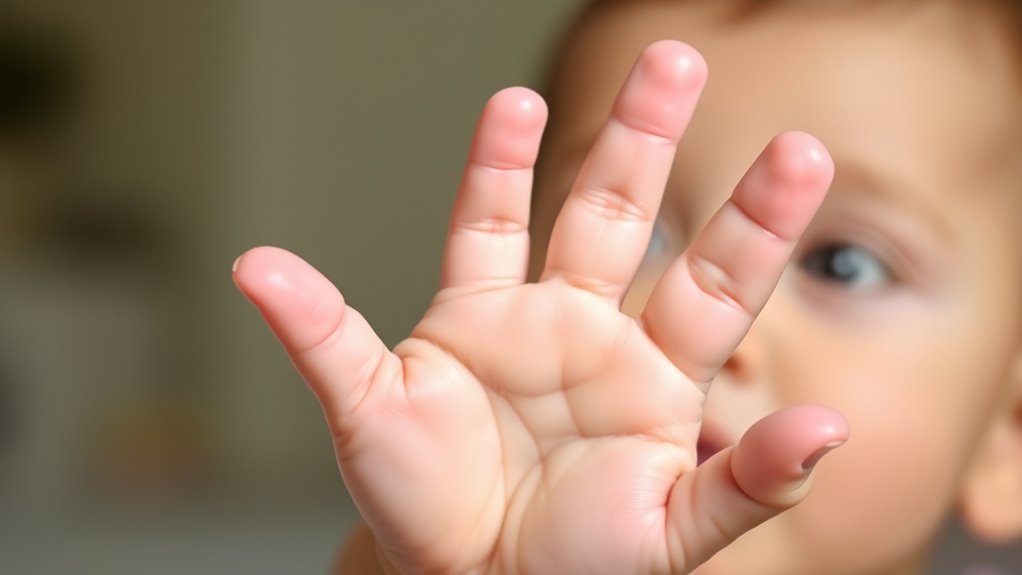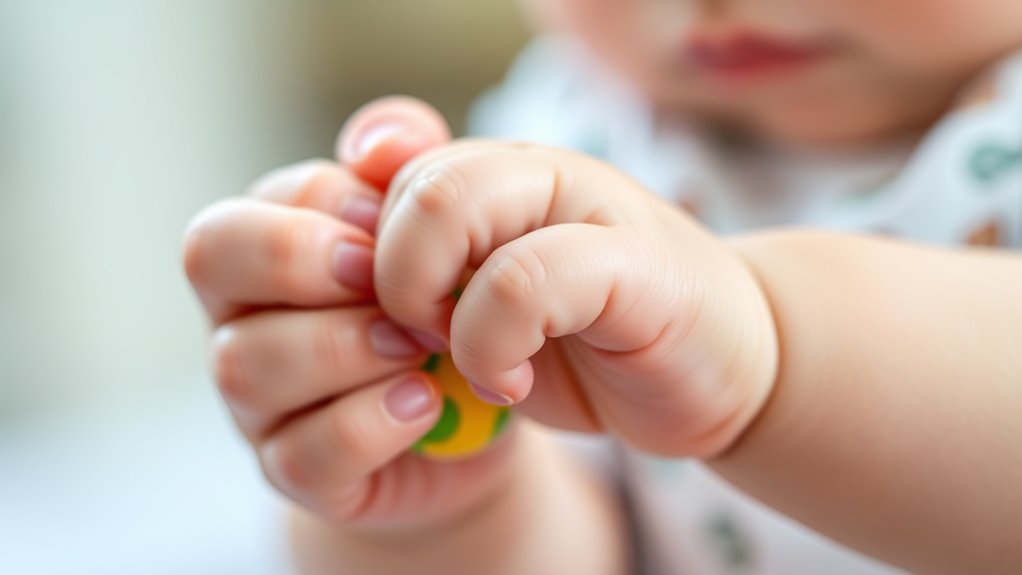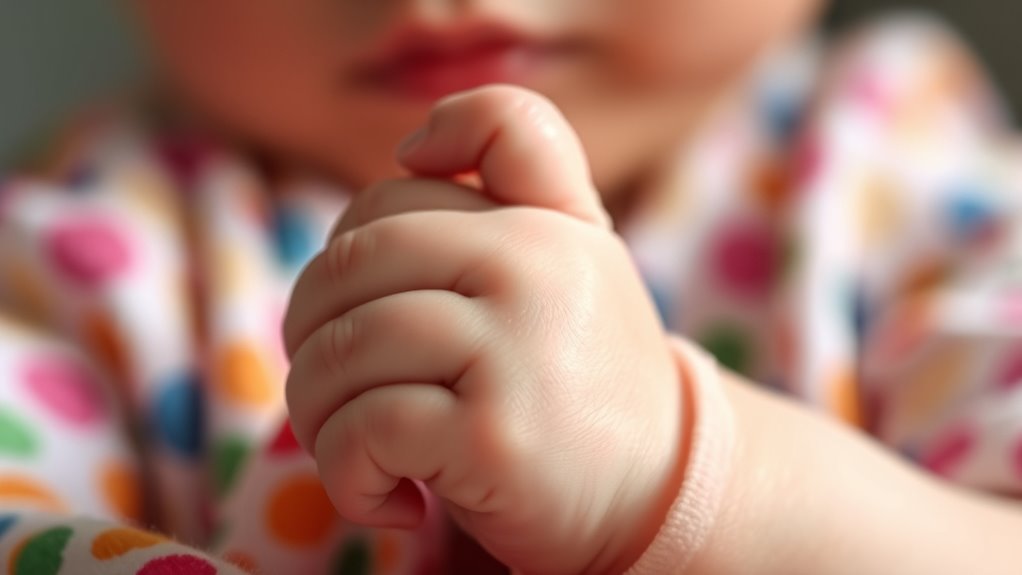As your baby develops, they’ll progress from reflexive grasping to intentional reaching and then to a precise pincer grip by around 9 to 12 months. During this time, they gain better hand-eye coordination, muscle strength, and control, allowing them to pick up small objects and manipulate toys with accuracy. Supporting their exploration with activities like stacking and shaping helps refine these skills. Continue exploring ways to aid their fine motor milestones as your little one advances.
Key Takeaways
- Infants progress from involuntary reflexes to intentional reaching and grasping between 4-6 months.
- Fine motor skills refine with improved hand-eye coordination, enabling object manipulation and exploration from 6-9 months.
- The development of the pincer grip begins around 9-12 months, allowing precise picking up of small objects.
- Activities like stacking blocks, shape fitting, and textured exploration support grip refinement and finger strength.
- Consistent, enjoyable practice with sensory-rich activities enhances overall fine motor development in infancy.
The Birth to Three Months Stage: Reflexes and Early Grasping

During the first three months of life, your baby’s motor development is driven mainly by reflexes and early grasping. Infant reflexes, like the Moro or rooting reflex, serve as automatic responses to stimuli, helping your baby adapt to their environment. Early grasping is a natural reflex where your baby instinctively wraps their fingers around objects placed in their hand. You’ll notice these movements are involuntary and consistent, providing a foundation for future coordination. During this stage, your baby’s hands often close around your finger or a toy, demonstrating their developing reflexes. These early behaviors are essential milestones, laying the groundwork for more voluntary hand movements later on. Recognizing these reflexes helps you understand your baby’s growth and neurological development. Motor development during this period is closely linked to neurological milestones that set the stage for later voluntary movements. Additionally, understanding the significance of reflex patterns can help you monitor your baby’s neurological health as they grow.
Developing Hand Control: Around Four to Six Months

Around four to six months, you’ll notice your baby reaching for objects and trying to grasp them. Their hand-eye coordination improves as they begin to transfer objects between hands and explore with their fingers. This stage marks significant progress in developing fine motor skills through object manipulation and controlled movements.
Reaching and Grasping
Between four and six months, infants rapidly develop their hand control, enabling them to reach for and grasp objects with increasing coordination. During this period, hand muscle development becomes more sophisticated, giving your baby better strength and precision. They start extending their arms and reaching out intentionally, guided by improved sensory integration that helps them interpret visual and tactile cues. As their muscles strengthen, they begin to open and close their hands more purposefully, grasping objects with greater control. You’ll notice your little one exploring different shapes and textures, honing their ability to grasp and hold. This stage sets the foundation for more refined movements, gradually progressing towards more complex fine motor skills. Reaching and grasping are essential steps in your baby’s overall motor development journey.
Hand-Eye Coordination
As your baby gains better control over their hands, their hand-eye coordination begins to improve markedly. They start to coordinate their visual tracking with hand movements, reaching more accurately for objects. During this stage, you might notice their hand dominance starts to emerge, though it’s not fully established yet. This period marks an important milestone in developing their fine motor skills. To support this progress, encourage activities like guiding their hands to follow moving toys or objects. Observe how they focus their gaze and reach simultaneously. Here’s a quick overview:
| Skill | Typical Age Range | Observation Tips |
|---|---|---|
| Visual tracking | 4-6 months | Watch for smooth, deliberate movements |
| Reaching accuracy | 4-6 months | Notice if they aim well at objects |
| Hand dominance | 4-6 months | Look for preference in hand use |
| Hand-eye coordination | 4-6 months | Combine visual focus with reaching |
| Fine motor refinement | 4-6 months | Observe improved grasp and control |
Additionally, understanding appliance maintenance plans can help ensure safety and longevity of household appliances, which parallels the importance of nurturing safe and effective motor development in babies.
Object Manipulation Skills
Have you noticed your baby beginning to grasp and explore objects with more control? At this stage, they’re honing their object manipulation skills through sensory exploration. Your little one may reach, grasp, and shake toys to discover textures and sounds, strengthening their hand muscles in the process. This muscle strengthening is essential for developing finer motor skills, as their hands become more coordinated and precise. Expect them to transfer objects between hands and explore different shapes and sizes. These actions not only boost muscle control but also enhance their understanding of object properties. Encourage safe exploration by offering a variety of toys that promote grasping, squeezing, and mouthing. Engaging with sensory-rich materials can further stimulate their tactile development. Your baby’s increasing control marks an exciting step toward more refined motor milestones.
Reaching and Grasping: Building Coordination in Six to Nine Months

During this stage, your baby refines hand-eye coordination as they reach for objects with more accuracy. They also begin to manipulate items, exploring different grips and movements. These milestones mark significant progress in their ability to coordinate actions and control their fine motor skills. Using self-watering plant pots as an example, this progress can be likened to the controlled moisture delivery that helps plants develop healthily without overwatering. As they gain better control, they start to understand the development of fine motor skills and how their actions influence objects around them.
Hand-Eye Coordination Development
Between six and nine months, infants rapidly improve their hand-eye coordination as they learn to reach and grasp objects. This development hinges on sharpening visual perception and sensory integration, enabling you to coordinate your movements smoothly. During this stage, you’ll notice babies aligning their gaze with their hands, improving accuracy. Additionally, this period marks significant progress in sensory processing, which supports more precise movements. The table below highlights key milestones:
| Skill | Developmental Progress |
|---|---|
| Reaching accuracy | Better targeting of objects |
| Grasp timing | Coordinating visual cues with movement |
| Hand positioning | Adjusting grip based on visual feedback |
| Sensory integration | Combining touch and sight for control |
This progress lays the foundation for more complex object interactions, boosting overall fine motor skills. Recognizing the importance of visual perception can help caregivers support this critical milestone effectively. Engaging in sensory experiences further enhances this development by stimulating the brain’s ability to process multisensory input. Supporting visual perception through focused activities can accelerate progress during this stage.
Object Manipulation Skills
How do infants develop the ability to reach and grasp objects effectively? During this stage, sensory exploration plays a key role as your baby learns about object properties through touch, sight, and movement. Their hand strength gradually increases, allowing them to hold and manipulate objects with more control. As they practice reaching, their coordination improves, helping them extend their arms accurately toward targets. Your baby begins to explore different textures and shapes, which enhances their understanding of object characteristics. This exploration also helps refine hand movements, making grasping more precise. Additionally, as they experiment with various objects, they develop a better sense of object properties, which supports their overall cognitive development. Regular exposure to different objects encourages sensory development, which is crucial during this period. Over these months, their developing hand strength and sensory experiences work together to build the foundation for more complex object manipulation skills, preparing them for future milestones like pincer grip and fine motor precision.
Reaching and Grasping Milestones
Reaching and grasping also boost social interaction, as they often reach for familiar faces or toys during playtime. You might notice them:
- Improving hand-eye coordination
- Using both hands to explore objects
- Reaching for objects beyond their initial grasp
- Developing intentional, purposeful movements
- Responding to visual and auditory cues
These milestones mark important progress in their motor development, setting the foundation for more complex skills like pincer grip and fine motor control. This stage is vital for fostering curiosity, learning, and social bonds. As their coordination improves, they begin to explore environmental stimuli more extensively, further supporting their sensory and motor development. Recognizing these milestones can also help caregivers understand the importance of early childhood development and provide appropriate opportunities for practice and growth. Developing motor planning skills during this stage is crucial for future tasks involving precise movements. Incorporating multi-functional furniture and organized play areas can facilitate safe and effective exploration during this critical period.
The Transition to Pincer Grip: Fine Tuning Dexterity at Nine to Twelve Months

During the nine to twelve-month period, infants typically refine their grasping skills by shifting from a crude pincer to a more precise pincer grip. You’ll notice your baby using their thumb and forefinger as a finger pincer to pick up small objects, demonstrating increased dexterity. This progression marks the development of a true precision grip, allowing for more controlled and delicate movements. Your infant begins to manipulate objects with greater accuracy, such as pinching a small piece of food or picking up tiny toys. This fine-tuning of finger movements is essential for later skills like writing and buttoning. As your baby masters the finger pincer, you’ll see improvements in their hand-eye coordination and overall fine motor control, signaling significant developmental progress. The importance of encouraging these skills can foster confidence and independence in your child’s everyday activities. Supporting this development through appropriate toys and activities can further enhance their fine motor skills and promote steady progress. Engaging your infant in developmentally appropriate tasks can also stimulate their interest and motivation to refine these skills further.
Encouraging Hand and Finger Strength in Infants

To support your infant’s hand and finger strength, incorporate activities that encourage grasping, squeezing, and pulling. These actions help develop hand strength and improve finger dexterity. Providing soft toys or textured objects for your baby to hold and squeeze fosters muscle development. You can also offer toys that require pulling or tugging, which boosts grip strength. Encourage your infant to transfer objects between hands to enhance coordination. Engaging in gentle finger play, like finger puppets or hand games, promotes finger dexterity. Additionally, letting your baby explore different textures and shapes stimulates both hand strength and fine motor control. Using appropriate toys that are designed to support fine motor development can further enhance these skills. Remember, consistent practice with these activities will help your infant progress towards more precise movements and stronger hand muscles.
Activities to Foster Fine Motor Skills Development

Engaging your infant in purposeful activities can considerably enhance their fine motor skills. Sensory exploration is key—allow them to touch different textures, play with soft fabrics, or explore water and sand. These activities strengthen hand muscles and improve coordination. Musical activities also boost fine motor development; singing songs with hand motions or offering simple instruments like shakers or drums encourages grasping and finger movements. You can encourage your baby to reach for and grasp objects during play, fostering pincer grip skills. Incorporate activities that promote controlled movements, such as stacking blocks or fitting shapes into corresponding holes. Consistent, enjoyable practice helps your infant refine their hand-eye coordination, finger dexterity, and overall fine motor abilities, setting a strong foundation for future skill development.
Recognizing Typical and Atypical Motor Development Signs

Understanding the typical milestones in motor development helps you identify when your infant is progressing normally or may need extra support. Watch for signs like reaching for objects, transferring items between hands, and developing hand-eye coordination. Atypical signs may include poor sensory processing, such as overreacting or underreacting to touch, or persistent asymmetry in hand movements. Keep an eye on your baby’s posture and muscle tone, as delays here can indicate underlying issues. Parental guidance is vital—consult with healthcare providers if milestones are delayed or if your infant shows signs of discomfort during activities. Recognizing these signals early allows you to seek appropriate intervention and support your child’s development effectively.
- Achieving age-appropriate grasping and reaching
- Consistent hand preference or asymmetry
- Sensory sensitivities affecting hand use
- Muscle tone abnormalities or poor postural control
- Delayed hand-eye coordination development
Supporting Your Baby’s Progress Toward Precise Pinching

Supporting your baby’s progress toward precise pinching involves encouraging opportunities for grasping small objects, such as Cheerios or beads, which help refine finger movements. These activities promote sensory integration, allowing your baby to coordinate touch and movement effectively. Parental support plays a vital role by providing safe, accessible objects and demonstrating how to pick them up gently. Offering varied textures and sizes enhances sensory input, strengthening finger dexterity. As your baby practices pinching, they develop better grip control and hand-eye coordination. Be patient and praise small successes, fostering confidence and motivation. Creating a calm, encouraging environment helps your baby focus on refining their fine motor skills. With consistent support and sensory-rich experiences, your baby will gradually master the pincer grip.
Frequently Asked Questions
When Should I Start Introducing Toys to Promote Fine Motor Skills?
You should start introducing toys around 3 to 6 months to support developmental milestones. Toys that encourage grasping, reaching, and exploring help strengthen fine motor skills. As your baby grows, provide age-appropriate toys that challenge their pincer grip and hand-eye coordination. Watching how your little one interacts with toys allows you to gauge their progress and guarantees they’re developing essential skills in a fun, engaging way.
How Can I Differentiate Between Normal and Delayed Motor Development?
Think of motor milestones as your child’s unique symphony. To spot normal versus delayed development, observe their progress in reaching milestones like grasping or crawling. Regular developmental screenings help guarantee they’re on track. If your child struggles markedly or misses key milestones beyond typical age ranges, consider consulting a pediatrician. Remember, every child develops at their own pace, but timely checks can catch delays early and guide appropriate interventions.
Are There Specific Signs Indicating My Baby Needs Professional Assessment?
If you’re wondering whether your baby needs a professional assessment, look for signs like persistent delays in reaching motor milestones, difficulty with fine motor skills, or limited movement. Early intervention and developmental screening can identify issues early, helping your baby get the support they need. Trust your instincts and consult a pediatrician if you’re concerned, as timely action can promote better developmental outcomes.
What Activities Are Best for Infants With Limited Hand Mobility?
Oh, you’re thinking about the best activities for your little one with limited hand mobility? Well, get ready for some hand strengthening fun! Sensory play is perfect—think textured toys and water play that encourage grasping and finger movement. These activities boost fine motor skills, keep your baby engaged, and help develop their pincer grip naturally. Just remember, patience and encouragement go a long way!
How Does Nutrition Impact My Baby’S Motor Skill Development?
Nutrition plays a crucial role in your baby’s motor skill development. Proper developmental nutrition guarantees ideal nutrient absorption, providing essential vitamins and minerals that support brain and muscle growth. When your baby receives balanced, nutrient-rich foods, it boosts their coordination, strength, and fine motor skills. Focus on offering a variety of healthy options to promote overall developmental progress, helping your little one reach key milestones more effectively.
Conclusion
Remember, patience is a virtue as your baby progresses from grasping to mastering the pincer grip. Every little milestone is a step forward in their development journey. Stay encouraging and provide plenty of opportunities for practice and exploration. Like the saying goes, “Rome wasn’t built in a day,” so celebrate each small success along the way. With your support, your little one will develop fine motor skills and confidence in no time.










